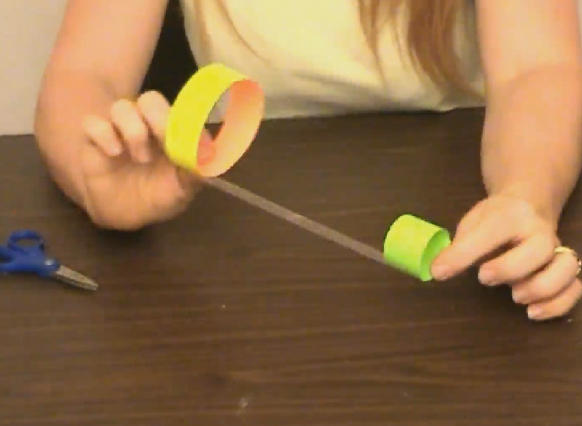Why can this thing fly? It doesn’t even LOOK like a plane! When I teach at the university, this is the plane that mathematically isn’t supposed to be able to fly! There are endless variations to this project—you can change the number of loops and the size of loops, you can tape two of these together, or you can make a whole pyramid of them. Just be sure to have fun!
Materials: Index card, straw, scissors, tape.


i would like to know how this thing can fly please
Yes, the video is how you can learn how to put this project together. Try watching again, and let me know if you have specific questions.
I cant do the hoopster one can you teach me?
Could you explain why the 1.14 ring thing can fly?
P.S. I also added some powder to see the airflow over the thing inside the tunnel
Hope this does help,
Aashman (age 11)
Cool! (reffering to the upcoming wind tunnel) I had built one based on various expirements on this website. it had a floor fan with a part metal box with a hole in the top hot glued to it. I had installed a tuning capacitor and a transparent window to it.
– Aashman (age 11)
Funny you should bring this up… I am working on an experiment video now that shows how to make a home-version of a wind tunnel… it will be in Unit 20. 🙂
Wouldn’t it be cool to see this thing in a wind tunnel? I’d love to see how the air currents flow around the rings and straw!
Oops – looks like my response to this question was filed under a different experiment. Ok – here it is again:
There are FOUR forces at work with your flying machine. Gravity is always pulling it down, but air keeps it up (lift). The way airplane wings generate lift is by having a curved surface on the top which decreases the sir pressure, and since higher pressure pushes, the wing generates lift by moving through the air. But what about a flat wing?
If you drop a regular sheet of paper, it flutters to the ground. If you wad it up first, you’ll find it falls much faster. The air under the falling paper needs to get out of the way as gravity pulls the paper, which is a lot easier when the paper is wadded into a ball. For a flat wing (like on a paper airplane) to glide through the air, it needs to be balanced between gravity and the air resistance holding it up. In order for a glider to fly, the center of pressure needs to be behind the center of gravity. By adding paper clips to your paper airplane, you move the center of gravity and center of pressure around to find the perfect balance.
When we use math to add up the forces (the pull of gravity would be the weight, for example), it works out that there isn’t enough lift generated by thrust to overcome the weight and drag. When I say, “mathematically speaking…” I mean that the numbers don’t work out quite right. When this happens in science for real scientists, it usually means that they don’t fully understand something yet. There are a number of ‘unsolved’ mysteries still in science.. maybe you’ll be able to help us figure them out?
You are good at explaining why things work. Why does this mathematically non-flying thing work?
This airplane design reminded us of an air boat.